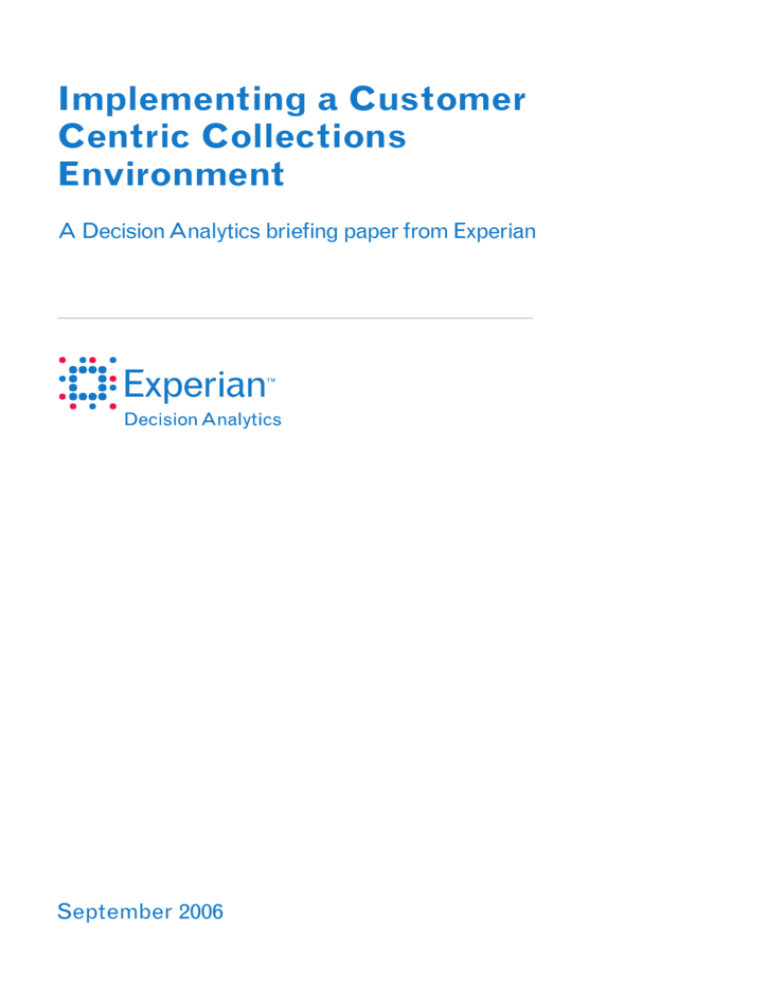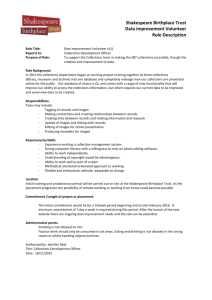
Implementing a Customer
Centric Collections
Environment
A Decision Analytics briefing paper from Experian
September 2006
Introduction
Taking a holistic view of the customer enables lenders
to deploy collection strategies that are closely
matched to both the value of the customer and the
overall credit risk they represent. The end result is
more effective collections performed at lower cost
combined with improved customer relationships. This
ability to manage payment arrears and revenue
collections at a customer level is known as ‘customer centric
collections’.
The situation
A customer-centric approach to collections can have a number of impacts, not
least a heightened level of customer satisfaction and a subsequent reduction in the
level of queries and resultant bad debts.
Best of breed software solutions can assist in this process by providing a
comprehensive range of customer centric collection tools. What this means in
practice is:
• Customer centric management of portfolio
• Customer centric view of exposure
• Minimisation of scope for customer reasons for non-payment
One of the methods being employed is that of a holistic view whereby the total
customer exposure can be viewed and managed via a customer centric approach
and not just at the level of individual overdue accounts.
In addition, a customer centric collections system can facilitate improved targeting
and cross selling of complementary products and services such as credit cards,
loans, insurance and so on, whilst simultaneously reducing the organisation’s risk
profile.
Long term benefits
Optimised use of
resources
There can be many benefits from employing a customer centric collections model,
not least:
• A level of contact appropriate to the customer’s value to the lender
• Improved customer satisfaction & loyalty
• Clear cost benefits (fewer client contacts)
• Improved collection rates
• Reduced company exposure & risk
• Early identification of accounts ‘at risk’ and the propensity to pay
A best of breed collections solution enables customer centric management of
accounts, providing an overall picture of the customer’s indebtedness within the
enterprise. Essentially this allows not only the overdue account to be visible but
also the ability to look at the whole exposure of the customer across multiple
products and channels.
In this way the system is introducing the concept of Customer Revenue
Management – an extension of the traditional debt management solution.
Implementing a Customer Centric Collections Environment - 2
The benefits of taking this approach can be seen to include:
• Timely, accurate targeting of debtors in a consistent and prioritised manner
• Single point of contact
• Increased collection rates and productivity combined with reduced roll rate
and write-off levels contribute to an optimised return on investment
• Reduced communication costs (letters, phone calls etc)
Before commencing on a customer centric collections project, it would be prudent
to analyse the current portfolio mix in terms of how many clients have only one
product, 2 products, and 3 or more. From this analysis, it will be apparent to what
extent the current client-base could benefit from employing customer level
collections and so give an indication as to the potential scale of the return on
investment.
Similarly, to maximise the benefits of implementing this approach, best use of
internal performance data (such as first payment defaulters), supplementary credit
bureaux data and customer scorecard data should be utilised if possible.
Challenges to
successfully
implementing a
customer centric
collections
encironment
Organisational Challenges
Traditionally, collections call centres have been set-up to effectively manage
individual product sets within the business’s portfolio. As a result there are islands
of expertise within the organisation to deal with each of the products in question.
In effect a product centric collections strategy. As lending organisations have
grown through mergers and acquisition, the number of different products being
offered and different collections teams used to manage arrears has also
increased.
There is a key issue that needs to be addressed when a business is organised
departmentally in terms of products (silo based). When this is the case, there
needs to be increased levels of communication between each of the departments
to ensure that the customer contact levels are kept to a minimum when dealing
with a client with more than one product. It should be made very clear as to the
exact course of action within each department when a particular product or
products enters the collection arena.
Therefore, to be able to effectively manage a customer in a holistic manner the call
centre agents will need some re-training to ensure each collector has sufficient
knowledge about all of the products the customer might hold.
As an example, there may well be a call centre for checking account management
but when a move is made to customer level collections they will need to have an
appropriate level of knowledge about mortgages, loans, insurance and so on such
that they can correctly evaluate the action to be taken and the advice to be given to
the customer.
Savings
Products
Checking
Accounts
Mortgages
Loans
Other
Products
Customer
acquisition
Customer
acquisition
Customer
acquisition
Customer
acquisition
Customer
acquisition
Customer
service
Customer
service
Customer
service
Customer
service
Customer
service
Collections
Collections
Collections
Collections
Collections
A traditional product centric model with little or no integration between the
business silos
Implementing a Customer Centric Collections Environment - 3
An alternative strategy could be to organise the collections call centre such that
there are one or more teams dedicated to multi-product debtors, the size of the
teams being relative to the portfolio mix of single versus multi-product debtors.
An effective ‘half way’ approach can be to employ the ‘customer view’ method,
whereby each department still manages the customer but in a product centric
manner. However, when arrears first appear in product department A, a warning
alert or referral to the other product departments could be initiated as a pre cursor
to possible further arrears occurring in their department. The other departments
being forewarned are therefore forearmed.
Savings
Products
Checking
Accounts
Mortgages
Loans
Other
Products
Customer
acquisition
Customer
acquisition
Customer
acquisition
Customer
acquisition
Customer
acquisition
Customer
service
Customer
service
Customer
service
Customer
service
Customer
service
Collections
Collections
Collections
Collections
Collections
A customer view model model with integration between collections departments
Strategy Definition
In some ways the cascade of arrears can be compared to Maslow’s1 hierarchy of
needs in terms of a pecking order of what is important. A typical case could be that
a customer’s checking account initially enters the collections system due to an
overdraft limit that has been exceeded. Next on the agenda is the credit card
balance increasing and ultimately breaching the shadow limit or credit limit.
Following this could be loans being one or more cycles down and then ultimately
the mortgage moves into arrears.
In all of the above scenarios, there needs to be a matrix of decisions (Strategies)
as to the best approach to deal with the delinquent customer.
Examples of some alternative collections strategies that could be deployed are as
follows:
• Once a product has entered the collections process, it could continue on the
standard path for this particular arrears profile, irrespective of the number of
products in arrears. The collector uses the customer level view as collateral
when negotiating payment terms with the debtor.
• As above but accelerating the speed of the collections process each time an
additional product moves into arrears or the risk level / category is
increased.
• Each time an additional product enters collections, the customer is reevaluated and re-routed to the most relevant course of actions based on
factors such as customer level credit risk and behavioural scoring models.
Similarly when there are additional accounts held by a particular customer that are
performing well, then the collections process could be decelerated to give more
time for accounts to self-cure.
An added complexity that will occur is how to deal with each of the products when
each of them is likely to be at different delinquency levels. For example:
Customer A has:
• Checking account has exceeded limit for 3 months
• Loan that is 2 months in arrears
• Mortgage that is one month in arrears
Implementing a Customer Centric Collections Environment - 4
When the collector agrees with the debtor on measures to be taken to redress the
situation, a view needs to be taken as to how monies paid to the organisation are
apportioned to each of the products and what should be monitored and when.
In real terms, what the customer is hopefully trying to agree is along the lines of:
• Return mortgage to current by agreeing a payment arrangement over 6
months
• Return loan back to current by agreeing a payment arrangement over 4
months
• Bring the checking account to within the overdraft limit within a month
Quite quickly it becomes apparent that there can be a complex web of decisions
that need to be made when dealing with a customer in this situation. Similarly,
every other combination of overdue accounts, age, one or more products in arrears
need to be considered so that the best action can be taken at the appropriate time.
Failure to meet the above agreements could entail a different action being taken on
each of the products, thus returning to the product centric model.
Savings
Products
Checking
Accounts
Mortgages
Loans
Other
Products
Customer
acquisition
Customer
acquisition
Customer
acquisition
Customer
acquisition
Customer
acquisition
Customer
service
Customer
service
Customer
service
Customer
service
Customer
service
EAI Layer
Collections
A customer centric model where all collections operations are handled by one
team with access to all information across all of the products
Managing Customer Relationships
There is a further level of customer centric collections that can be deployed where
local regulations allow. This is to link related parties so that an even more holistic
view may be achieved and an appropriate collections strategy implemented.
For example, a view of a customer’s individual products should also include any
jointly-owned products he or she holds - such as a joint checking account with a
partner, or a joint mortgage with another family member.
In addition, where appropriate, business products where the customer is the sole
owner should also be taken into account for a truly customer centric view.
Implementing a Customer Centric Collections Environment - 5
Business
Mother
Father
Son
Smith’s Decorating
Mrs Smith
Mr Smith
Mr Smith
Checking
Account
Savings
Account
Business
Loan
Checking
Account
Savings
Account
Checking
Account
Savings
Account
Checking
Account
Savings
Account
Personal
Loan
Mr and Mrs Smith
Joint
Checking
Account
Joint
mortgage
Joint
Investment
Account
Joint
Mortgage
A customer centric product relationship model
Regulatory Issues
With particular regard to the point above, one item that should not be overlooked is
the presence of any regulatory restrictions within the country of operation. For
example the Data Protection Act in the UK is quite restrictive in terms of sharing
information within an organisation where clients take multiple products.
Technical Challenges
Traditional collections systems contain information relating to delinquent products
only and do not include currently performing products. As a result one of the key
requirements when employing customer level collections is the ability to view and
manage all products owned by the debtor in question.
Within the collections system, the ability to readily store and employ a data model
that supports the hierarchy of a customer with one or more accounts with one or
more products is essential. Similarly, the ability to ‘associate’ one account with
another via ‘soft’ rules can be very advantageous when linking accounts and
customers together where the hosts systems do not have a fixed link such as a
common data model and / or customer number.
Access to data
The minimum requirement here is to be able to know how many other products the
customer has and at what stage (such as age, risk, value etc) they are in the
collections process.
Therefore, the movement of a single account into collections can trigger the
request for information from multiple other systems to complement the existing
data within the collections system.
Access to the above information would enable the customer centric ‘view’ to be
achieved.
The next step would be to allow all products to be contained and managed within
the collections environment. Therefore at the point an account moves into
Implementing a Customer Centric Collections Environment - 6
collections then all related account details need to be visible in the collections
environment from that point onwards.
An extension of this then allows the prospect of customer service (non-delinquent
accounts) to be managed within the system as all accounts are present in the
system.
Feedback
One key requirement in this area is obviously the ability of the collections system
to integrate with a variety of hosts and their associated technologies.
A key requirement is the provision of feedback to the various host systems.
Particularly important is the feedback to the scoring models, customer service
system, the originating host systems and indeed front end systems such as the
marketing database.
As a result of closing the feedback loop, future decisions can be evaluated, refined
and targeted more accurately.
Identifying the client
Conclusion
When integrating a number of potentially disparate systems, one key requirement
is to be able to logically group accounts for a customer together. Often there is no
categorical connection between the systems such as a common customer number.
As a result the collections system needs to be able to build relationships to ensure
that the accounts and the resultant overall exposure can be evaluated, presented
and appropriate action thus taken.
There are three key areas of the business that need to be addressed when
deploying a customer centric collections strategy:
•
•
•
Organisational – the move from a product silo approach to a customer-led
approach
Technological – the need to integrate systems and data flow so that the
range of products held by customers can be seen in a holistic way
Human Resources – the need to equip and re-train collections staff to
understand the wider context in which the debtor is being managed.
While these are undoubtedly challenges, they are far from unsurmountable, and
the rewards for moving to a customer centric approach are significant. More
arrears can be collected more effectively at lower cost, and perhaps most
importantly, more customers can be “cured” and re-opened for the sale of more
products and services.
1
http://en.wikipedia.org/wiki/maslow’s_hierarchy_of_needs
Implementing a Customer Centric Collections Environment - 7
720 Waterside Drive
Aztec West
Almondsbury
Bristol, BS32 4UD, UK
Tel: +44 (0)1454 892000
Fax: +44 (0)1454 892030
Email: tallyman.info@experian.com
Website: www.experian-da.com
© Experian 2007
The word “EXPERIAN” and the graphical device
are trade marks of Experian and/or its associated
companies and may be registered in the EU, USA
and other countries. The graphical device is a
registered Community design in the EU.
All rights reserved.









